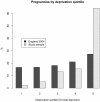Quantifying the impact of deprivation on preterm births: a retrospective cohort study
- PMID: 21826237
- PMCID: PMC3149630
- DOI: 10.1371/journal.pone.0023163
Quantifying the impact of deprivation on preterm births: a retrospective cohort study
Abstract
Background: Social deprivation is associated with higher rates of preterm birth and subsequent infant mortality. Our objective was to identify risk factors for preterm birth in the UK's largest maternity unit, with a particular focus on social deprivation, and related factors.
Methodology/principal findings: Retrospective cohort study of 39,873 women in Liverpool, UK, from 2002-2008. Singleton pregnancies were stratified into uncomplicated low risk pregnancies and a high risk group complicated by medical problems. Multiple logistic regression, and generalized additive models were used to explore the effect of covariates including area deprivation, smoking status, BMI, parity and ethnicity on the risk of preterm birth (34⁺⁰ weeks). In the low risk group, preterm birth rates increased with deprivation, reaching 1.6% (CI₉₅ 1.4 to 1.8) in the most deprived quintile; the unadjusted odds ratio comparing an individual in the most deprived quintile, to one in the least deprived quintile was 1.5 (CI₉₅ 1.2 to 1.9). Being underweight and smoking were both independently associated with preterm birth in the low risk group, and adjusting for these factors explained the association between deprivation and preterm birth. Preterm birth was five times more likely in the high risk group (RR 4.8 CI₉₅ 4.3 to 5.4), and there was no significant relationship with deprivation.
Conclusions: Deprivation has significant impact on preterm birth rates in low risk women. The relationship between low socio-economic status and preterm births appears to be related to low maternal weight and smoking in more deprived groups.
Conflict of interest statement
Figures



References
-
- Marmot M. Strategic review of health inequalities in England post-2010. 2010. Marmot review final report. University College London. wwwuclacuk/gheg/marmotreview/Documents.
-
- Behrman R, Butler A. 2007. Preterm birth: causes, consequences, and prevention: Natl Academy Pr.
-
- Goldenberg R, Iams J, Mercer B, Meis P, Moawad A, et al. What we have learned about the predictors of preterm birth. 2003;27:185. - PubMed
Publication types
MeSH terms
Grants and funding
LinkOut - more resources
Full Text Sources

